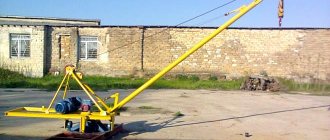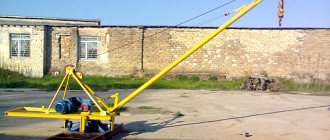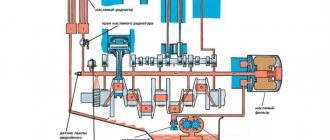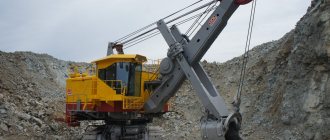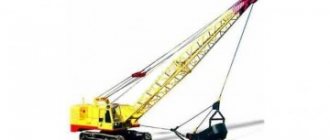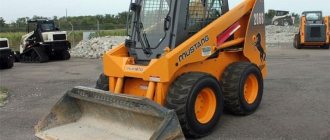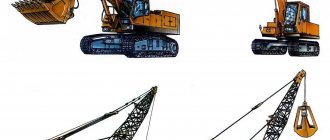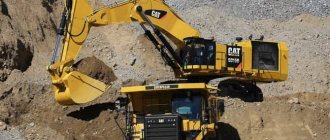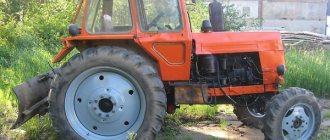An excavator is an earth-moving machine for excavating and dumping soil, which has greatly simplified road, construction work and mining.
Interesting to know! In the first half of the 19th century, it was estimated that steam-powered excavators replaced the labor of 100 people. Since then, the productivity of technology has increased many times. Thus, a mining excavator with its own operating weight of 3,500 tons has a daily planned coal production rate of 25,000 tons.
Purpose of excavators
According to their purpose, excavators are divided into groups:
- Road construction.
- Universal.
- Overburden.
- Underground.
- Career.
Refurbished equipment, along with new ones, successfully solves both road construction and other tasks of excavating and moving soil.
When purchasing new equipment is economically justified, enterprises consider machines with operating time. The service life of excavators is measured in engine hours before major repairs, and technical service consists of scheduled repairs and maintenance. Thus, a universal single-bucket excavator with operating time after technical procedures for restoration and replacement of worn components and parts in a specialized service is completely ready for operation at customer sites.
Popular models
Several well-known foreign manufacturers produce mining equipment. Similar machines are also produced in Russia. Among the leaders in the production of equipment for working in open fields are Hitachi and Caterpillar. Here are brief characteristics of modern popular models of these brands.
Hitachi
Hitachi is a leader in the global market in terms of sales of mining excavators. The model range includes two-track hydraulic machines with bucket volumes from 1.15 to 43 m3. Some characteristics of the models are shown in the table.
| Model | ZX470-5G | ZX670-5G | ZX870-5G | EX1200-6 | EX1900-6 |
| Engine | Isuzu AA-6WG1XQA | Isuzu BB-6WG1XQA | Isuzu BB-6WG1 XQA-04 | Cummins QSK23-C | Cummins QSKTA38-CE |
| Engine power, kW. | 235 | 312 | 360 | 567 | 810 |
| Weight, kg | 45600 — 47800 | 66800 — 68200 | 80800 — 84200 | 114 000 | 191 000 |
| Bucket type | Back | Reverse/direct | |||
| Bucket capacity, m3 | 1.15 — 2.65 | 2.5 — 3.5 | 2.9 — 4.5 | 5.2 — 6.7 | 4.4-12/11.0-15.0 |
| Digging depth, mm | 5920 — 9230 | 7120 — 9150 | 7140 — 8870 | 8050 — 9380 | 8180-14430/5920 |
| Digging height, mm | 10130 — 11420 | 11190 — 12240 | 12010 — 13820 | 12410 — 13460 | 14140-17900/14610 |
| Unloading height, mm | 6900 — 8390 | 7330 — 8330 | 8130 — 9740 | 8050 — 9080 | 9060-13200/10440 |
| Boom length, m | 6.3, 7 | 6.8, 7.8 | 7.1, 8.4 | 7.55, 9 | 8.3 |
| Handle length, m | 2.5-4.9 | 2.9-4.2 | 2.95-4.4 | 3.4, 3.6 | 3.6 |
| Bucket force, kN | 238.0 — 286.0 | 324.0 — 369.0 | 399.0 — 472.0 | 569 | 671/660-612 |
Table continuation
| Model | EX2600-6 | EX3600-6 | EX5500-6 | EX8000-6 |
| Engine | Cummins QSKTA50-C | Cummins QSKTA60-CE | Cummins QSKT50-CE | Cummins QSKT60-CE |
| Engine power, kW. | 1119 | 1450 | 1119x2 | 1450x2 |
| Weight, kg | 252 000 — 254 000 | 361 000 | 537 000/533 000 | 837000/825000 |
| Bucket type | Reverse/direct | |||
| Bucket capacity, m3 | 17.0/15.0 | 22/21-23 | 34/27-29 | 38-43/40 |
| Digging depth, mm | 3720/8250 | 8580/4160 | 8800/4550-4800 | 8400/4100 |
| Digging height, mm | 15010/15800 | 17690/16560 | 19700/18900-19200 | 19000/20500 |
| Unloading height, mm | 10350/10100 | 11590/10990 | 5200/13100 | 11900/13800 |
| Boom length, m | 8.7 | 9.6 | 10.1 | 9.8 |
| Handle length, m | 3.9 | 4.5 | 5.0 | 6.26 |
| Bucket force, kN | 830–760/ 943-873 | 1050 | 1480/1710-1590 | 2230 |
On models EX3600-6, EX5500-6 and EX8000-6, in addition to diesel engines, Hitachi TFOA-KK electric motors can be installed.
Traditionally, the equipment of this brand is distinguished by the use of economical and reliable engines and an efficient hydraulic system. Much attention is paid to the reliability and durability of the rotary unit. Performance is maintained in the widest range of external temperatures - both at +40? C and at -50? C.
Caterpillar
For quarrying, Caterpillar offers hydraulic excavators of varying power, as well as cable excavators that use an electric motor.
Hydraulic
Here are the characteristics of some models.
| Model | 340D L Series 2 | 6015/6015FS | 6018/6018FS | 6030/6030FS | 6090FS |
| Engine | Cat C9 | Cat C18/ Cummins QSK19 | 2 x Cat C18 | 2 x Cat C27 | 2 x Cummins QSK60 |
| Engine power, kW | 200 | 522/477 | 858 | 1140 | 3360 |
| Weight, kg | 38080 | 105600-107000 | 181000 | 296000/294000 | 980000 |
| Bucket type | Back | Reverse/direct | Straight | ||
| Bucket capacity, m3 | 2.60, 2.69 | 4.6-7 | 10 | 17/16.5 | 37-52 |
| Digging depth, mm | 7 322 | 7 300 | 8 500 | 13.9 | 20.2 |
| Boom length, m | 6.18 — 6.50 | 7.3 – 7.8 | 9 | 6.2 | 9.5 |
On the 60xx model, electric motors can be optionally installed instead of diesel ones.
Rope electric
Despite the fact that hydraulic excavators are increasingly used in quarrying, rope models continue to be produced, allowing them to be used effectively in stripping and ore mining.
Rope electric mining excavator CAT 7295
Thanks to the electric drive and large-capacity buckets, they allow you to move significant volumes of soil and rock at low cost.
The table lists the main characteristics of some models:
| Model | 7295 | 7395 | 7495 HD |
| Engine power, kW | 538-753 | 777-1 087 | 858 |
| Weight, kg | 789251 | 1288656 | 1306346 |
| Bucket capacity, m3 | 18.4-39.0 | 19,1-61,2 | 19,1-61,2 |
| Unloading height, mm | 9220 | 10000 | 10.6 |
| Boom length, m | 18 | 19.51 | 20.4 |
Effective development of deposits directly depends on the quality and efficiency of the equipment used. A large selection of mining excavators allows you to choose the right model, taking into account the type of rocks you will have to work with, the vehicles used, operating conditions and other factors.
H2: Classification of excavators
Earth-moving equipment is divided according to a number of characteristics, including dimensions, power, chassis type, etc. The main characteristic of an excavator is its operating weight. The greater the mass, the more useful work the equipment can perform per unit of time.
Table 1 Main types of buckets
Table 2 Classification of single-bucket excavators by weight
According to the type of operation of the machine, there are cyclic and continuous operation. Cyclic excavators are usually equipped with a single bucket and are designed for a wide range of applications: trenching, land clearing and grading, construction and road work.
Continuous excavators are multi-bucket equipment that is capable of simultaneously excavating rock and transporting it to a dump site thanks to the circular operation of the buckets.
A trench excavator on a tractor base is used for laying electrical cables and other communications. This machine is convenient for laying trenches and ditches of a given width and depth.
Dragline (pulling):
Dragline (pulling) is a rope-block equipment, which is a bucket attached to ropes.
Dragline is designed to develop layers below the equipment placement horizon.
Dragline design providing a working cycle includes:
– arrow;
– winch drums connected through teeth and couplings to separate engines;
– rope for scooping soil (lifting);
– a rope for pulling the bucket to the excavator (traction).
The bucket is lowered when the drum clutch is released; the lowering speed is regulated using the brakes. The development of the layers itself is carried out thanks to the significant weight of the bucket - falling from a height, it literally “bites” into the ground under the weight of its mass, which makes it possible to develop even hard, rocky rocks.
Significant dimensions make the dragline indispensable for:
– construction of dams;
– creating channels;
– cleaning the bottom of reservoirs;
– development of placer minerals;
– development of deposits where it is important to cleanse fossil deposits from the empty layer of upper rock.
The length of the dragline boom can reach 100 m, and the bucket capacity can be up to 168 m3.
How does an excavator work?
Using the example of a single-bucket excavator on pneumatic wheels, we will consider the design of this special equipment, which consists of the following main parts:
- Rotary support device.
- Pneumatic wheel running device.
- Outrigger.
- Rotating platform.
- Power point.
- Hydraulic cylinders of the boom, arm, bucket.
- Arrow.
- Handle.
- Ladle.
- Driver's cabin.
- Bulldozer blade.
Slewing ring
The excavator's slewing ring allows the machine platform to make a full rotation in both directions around a vertical axis. Increased demands are placed on the strength and reliability of this mechanism, since it takes not only the own weight of the platform with the equipment, but also wind loads and shocks during digging.
In modern models of excavators, slewing bearings based on slewing rings with balls or rollers in the form of rolling bodies are widely used. This design began to be used instead of a roller device and, due to the absence of a central centering pin in it, the weight was reduced, the turning resistance was reduced, maintenance was simplified, etc.
Hydraulic system
The excavator hydraulic system includes a set of components, parts and assemblies, including the following:
- Double adjustable pump with summative power adjustment.
- Valve block.
- Distribution equipment.
- Hydraulic motor.
- Hydraulic cylinders.
- Filters.
- Tank.
- Hydraulic lines.
- Connectors, fittings, fasteners.
Torque from the excavator's power plant is transmitted to the hydraulic pump shaft and converted into hydraulic energy, which, through control valves, drives the cylinders of the boom, arm and bucket of the machine.
Chassis
Excavators with pneumatic wheels have better maneuverability than equipment on a tracked chassis. In terms of cross-country ability and overcoming slopes and uneven soil, the caterpillar undercarriage has advantages over the pneumatic-wheeled chassis.
The chassis of a pneumatic wheeled excavator is the basis for a rotary platform with an engine and a working mechanism and consists, among other things, of the following parts:
- Support frame.
- Cardan shaft.
- Gearboxes.
- Folding supports.
- Front and rear axle.
- Dump.
- Wheels.
The excavator is driven by a hydraulic system and a hydraulic motor on the frame. The front axle is equipped with a turning mechanism, and the chassis is equipped with a service and parking brake system.
The chassis of a crawler excavator is made in the form of a frame, in the middle part of which there is a support with a gear rim. It includes the following elements:
- Drive unit.
- Hydraulic equipment.
- Caterpillars.
- Guides and support rollers.
- Track tension mechanism.
- Left and right closing covers.
The direction of movement of a crawler excavator changes thanks to the stopper of one of the tracks, the drive to which comes from a hydraulic motor through a multi-stage gearbox.
Electrical diagram
The electrical circuit of a diesel excavator consists mainly of an engine starting, lighting and warning system. The main elements that are included in the electrical equipment of diesel earthmoving equipment using the example of the E-652A excavator:
- Generator.
- Fuse box.
- Fan motor.
- Starter.
- Battery
- Ammeter.
- Rectifier.
- Front and rear lights.
Main components of machines
Excavators are complex special vehicles consisting of various mechanisms and components:
- power unit;
- chassis;
- hydraulic and transmission systems;
- reversible platform;
- cabin with control devices.
The working body is a bucket. It comes in different sizes, depending on the excavator model.
Important: it can be equipped with a hydraulic hammer or other earth-moving equipment.
Excavator operating principle
The power plant of a diesel excavator creates torque, which, through a mechanical drive, hydraulic lines, hydraulic pumps and a hydraulic motor, drives the chassis, rotary platform and working hydraulic cylinders of the machine on the boom, arm and bucket. The combustion energy of diesel fuel is converted into forward movement of hydraulic fluid, which, having completed its work, flows back into the hydraulic tank through a valve in the hydraulic line.
Knowing the design features, types and characteristics of excavators, you can choose a machine that will solve the production problems of the enterprise and increase the range of work they perform thanks to a wide range of attachments for various operations.
Crawler
What is a tracked excavator? This is a car that will travel on roads with any surface, as well as without it. The vast majority of self-propelled excavator equipment is placed on a crawler base. The exception is analogues operating within the city. The models under consideration will easily overcome loose soil, peat bogs, off-road conditions, forest and rock obstacles.
Safety rules for operation
All employees allowed to work with machines undergo qualification training, training in work rules and instructions from the security service. General conditions for normal operation of mechanisms.
- Before the first start: control of completeness;
- checking the quality of mounting fasteners;
- electronics condition assessment;
- closing all technical hatches and covers (moving parts must be fenced).
- inspection and preventive maintenance - only after the equipment has completely stopped;
Repair of rotary mechanisms must be carried out by specialists with confirmed qualifications (in accordance with the rules for welding work, rigging of heavy equipment, and plumbing repairs).
Buy a gearbox from the manufacturer
When planning to buy a swing gear , any investor intends to get the maximum from their investment. This problem can only be solved in one way: through the correct selection of equipment for a specific rotary mechanism. PTC Privod LLC, an experienced manufacturer of the gear market, will help you make this choice to your benefit.
We make and deliver our equipment throughout Russia. We guarantee decent quality and reasonable prices. Convince yourself of this by receiving a free consultation from specialists by phone or email. All contact details are in the contacts section.
Source
Advantages of a slewing gearbox
The specific purpose of the critical rotary gearbox determines the requirements for its design. Here, one of the first places is to ensure the utmost precision in the location of the gears: the surfaces of the gears must be in close contact, this is the only way to ensure normal operation of the device during rotation.
A well-thought-out design provides a number of advantages of rotation gearboxes:
- high efficiency (efficiency);
- compact dimensions (especially if it is a geared motor that combines an electric motor and a gear unit in a housing);
- simplified installation;
- reliability and excellent performance.

